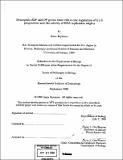Drosophila E2F and DP genes : their role in the regulation of G1-S progression and the activity of DNA replication origins
Author(s)
Royzman, Irena, 1970-
DownloadFull printable version (23.09Mb)
Advisor
Terry L. Orr-Weaver.
Terms of use
Metadata
Show full item recordAbstract
Late in Drosophila embryogenesis the cells giving rise to most of the larval tissues switch from a mitotic cycle to the endo cycle. The endo cycle consists of only S phase and a gap phase, leading to polyteny. It is preceded by the first detectable G1 period in Drosophila embryogenesis and developmentally regulated induction of S phase genes in the pattern of DNA synthesis. My analysis of the regulation of G1-S progression began with a genetic screen for mutations that disrupt the transcription pattern of S phase genes in mitotic and polytene cells of the embryo. A number of mutations in known and novel genes were isolated. Further analysis and phenotypic characterization has focused on the mutations that nearly eliminate the transcription of S phase genes in mitotic and polytene cells. These mutations are in the Drosophila homologs to the mammalian E2F and DP genes. The E2F transcription factor, a heterodimer of E2F and DP subunits, is linked to the G1-S transition in mammalian cells. Five mutations in the Drosophila DP gene (dDP) were isolated and provide the first opportunity to examine the in vivo role of this gene. Despite a pronounced effect on the G1-S transcription of S phase genes in dDP and dE2F mutant embryos, a block to replication was not observed. Null mutations in dDP and dE2F cause lethality late in development with some mitotic and polytene tissues being underdeveloped or absent. The mutant phenotypes reveal a positive role for E2F/DP in cell cycle progression in mitotic and endo cycle cells. Weak alleles of dE2F and dDP develop to adulthood and exhibit defects in oogenesis. Analyses of these mutants showed that E2F/DP controls differential regulation of replication origins within polyploid S phase. In ovarian nurse cells, E2F/DP limits replication of heterochromatic sequences. In follicle cells, E2F/DP is required to shut off genomic replication and activate the amplification of chorion loci. In addition to the positive and negative effects on the activity of replication origins, E2F/DP is necessary for nuclear lamin breakdown in nurse cells and subsequent nurse cell apoptosis.
Description
Thesis (Ph.D.)--Massachusetts Institute of Technology, Dept. of Biology, 1998. Includes bibliographical references.
Date issued
1998Department
Massachusetts Institute of Technology. Department of BiologyPublisher
Massachusetts Institute of Technology
Keywords
Biology